South Papua is a unique and diverse region in terms of its birdlife. It is home to a variety of birds, including many migratory species, as well as many endemic species.
There are over 600 species of birds in South Papua, including several endemic species, such as the magnificent Birds-of-Paradise. South Papua is also home to a number of threatened species, as well as several important bird areas.
Birdwatching in South Papua is a popular activity, and many birders visit the region each year to observe its avian diversity.
1. Raggiana Bird-of-Paradise
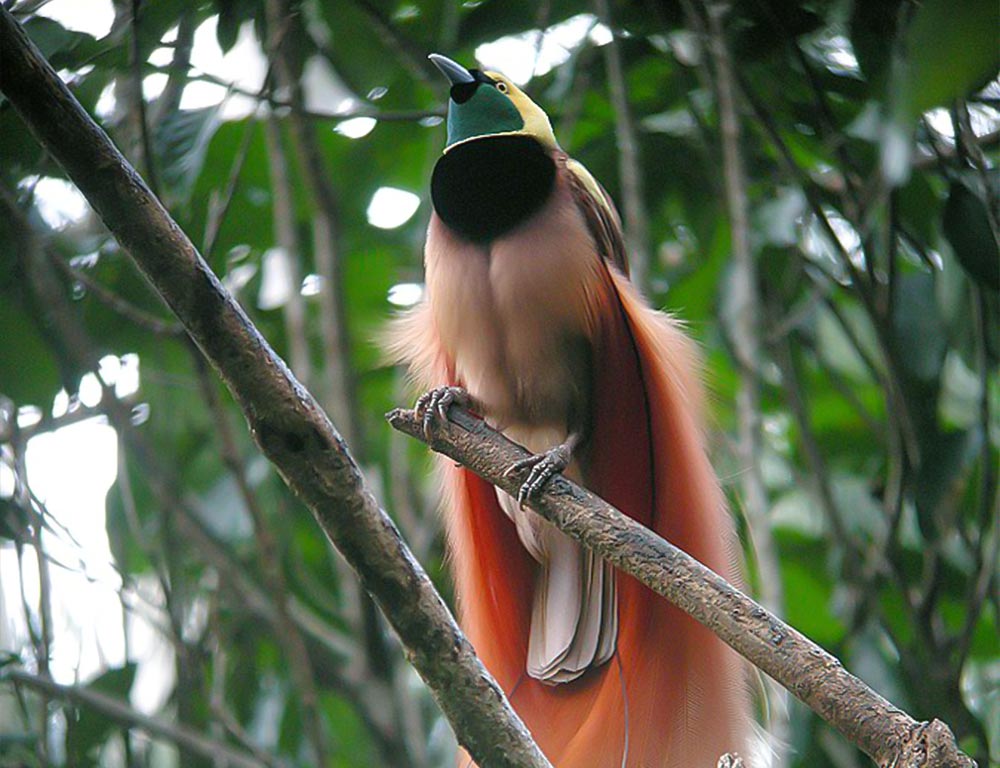
The Raggiana bird-of-paradise is an impressive species of bird found in New Guinea. It is a large bird in the Paradisaeidae family, which is commonly known as the bird-of-paradise family.
The bird is commonly known as Count Raggi’s bird-of-paradise and is named after the Italian naturalist Count Raggi who first identified it. It is widely distributed in both southern and northeastern New Guinea.
In the area, it is also referred to as the kumul, and in other regions, it goes by the name cendera wasih. The Raggiana bird-of-paradise is one of the most popularly known species of birds in its family.
Its bright colors, impressive size, and beautiful plumage make it a captivating sight. The bird is characterized by a striking iridescent blue throat, a bright yellow breast, and a bright orange abdomen.
Its long tail feathers, which are tipped with white, blue, and black, are particularly noticeable. The bird also has a prominent crest on its head, which is made up of two long black feathers.
The Raggiana bird-of-paradise is not only beautiful, but it is also a symbol of New Guinea’s unique biodiversity. This species is an important part of the local culture and is often used in traditional costumes and decorations.
This bird is also important to the local economy, as it is hunted for its feathers and food. Overall, the Raggiana bird-of-paradise is an impressive and majestic species of bird, which is not only beautiful but also a symbol of New Guinea’s unique biodiversity.
It is commonly known as Count Raggi’s bird-of-paradise and is widely distributed in southern and northeastern New Guinea, where it is known as kumul. The bird is also known as cenderawasih in other regions.
Its bright colors and impressive size make it a captivating sight, and it is an important part of the local culture and economy.
| Kingdom | Animalia |
| Phylum | Chordata |
| Class | Aves |
| Order | Passeriformes |
| Family | Paradisaeidae |
| Genus | Paradisaea |
| Species | P. raggiana |
2. Papuan Frogmouth
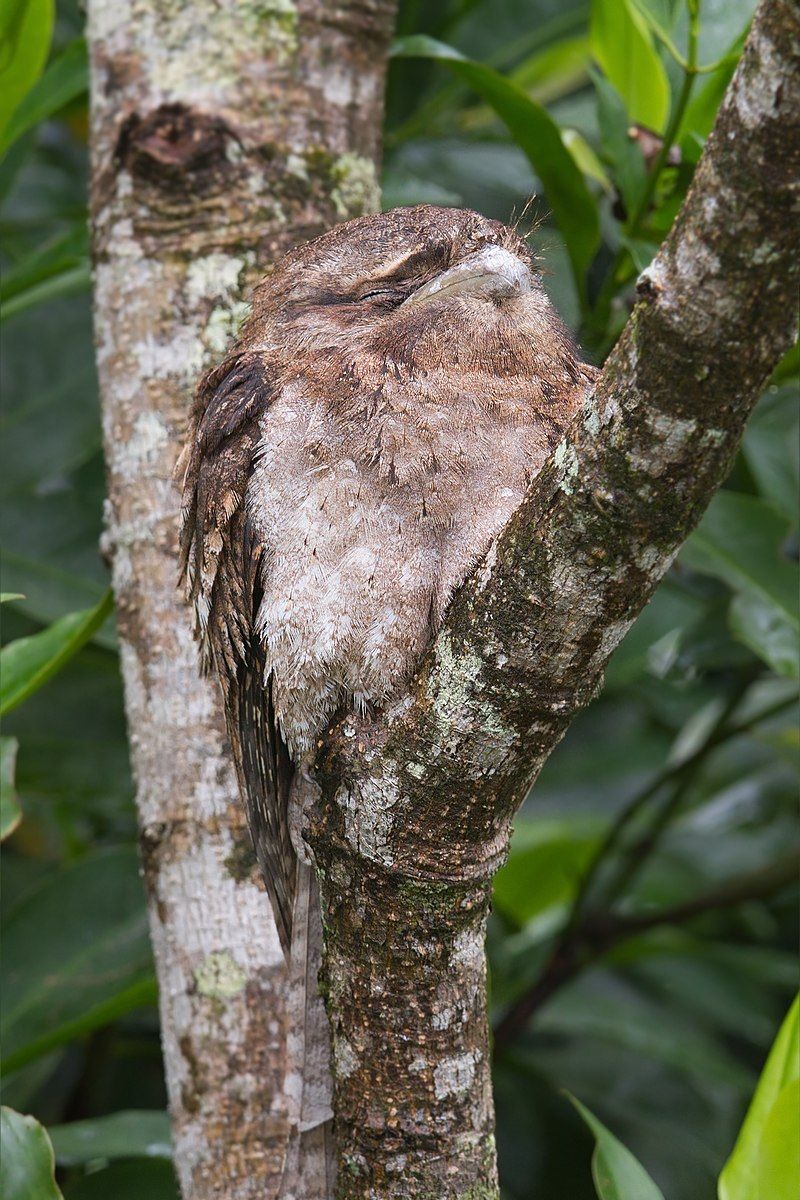
The Papuan frogmouth is a unique and interesting species of bird that belongs to the family Podargidae. This bird is native to the island of New Guinea and nearby islands, including the islands of the Bismarck Archipelago.
The Papuan frogmouth is a small bird, typically ranging in size from 16 to 22 cm. It has a large, rounded head, and a short tail. Its bill is short and broad, and its plumage is predominantly brown and grey. Its call is a loud, repeating hoot, with a softer second note.
It is mainly nocturnal and roosts in tree hollows during the day. It is mostly a sedentary bird and spends its time foraging for insects, small frogs, and berries.
The Papuan frogmouth is an uncommon species and is classified as Near Threatened on the IUCN Red List.
| Kingdom | Animalia |
| Phylum | Chordata |
| Class | Aves |
| Clade | Strisores |
| Order | Podargiformes |
| Family | Podargidae |
| Genus | Podargus |
| Species | P. papuensis |
3. Southern Cassowary
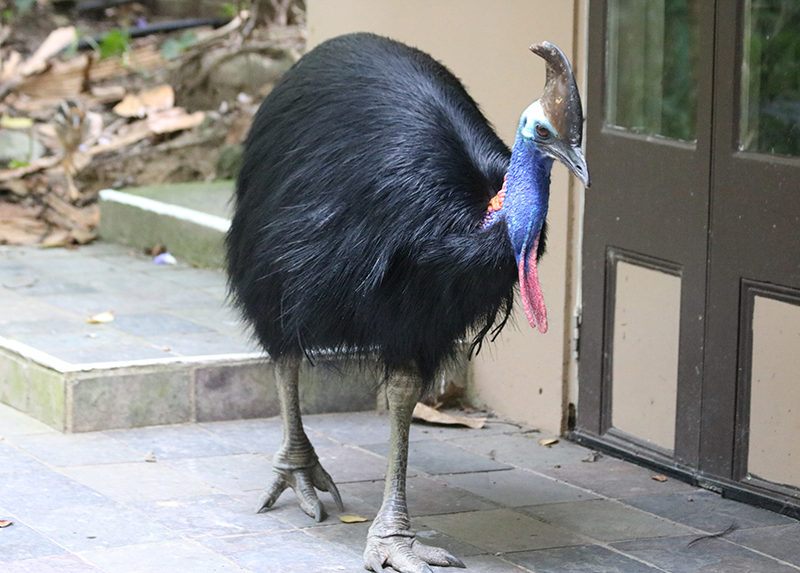
The southern cassowary is a large, flightless black bird that is part of the family of cassowaries. It is also known as the double-wattled cassowary, Australian cassowary, or two-wattled cassowary.
It is one of three living species of cassowary, along with the dwarf cassowary and the northern cassowary. The Southern Cassowary is native to Australia, New Guinea, and some of the smaller islands nearby.
It is the heaviest bird found in Australia and the second heaviest bird in the world, with an average weight of 77 pounds. It is a flightless bird, but it is capable of running at speeds of up to 31 miles per hour.
It has a long neck and black plumage with bright blue and red wattles around its neck. Its diet consists mainly of fruits, nuts, seeds, fungi, and small animals.
The Southern Cassowary is an endangered species due to habitat destruction, hunting, and predation by dogs and cats. The bird is also threatened by climate change, as a result of which its habitats are becoming increasingly dry and inhospitable.
The Australian government has taken several steps to protect this species, including the establishment of protected areas for the birds and the enforcement of laws that prohibit hunting. The Southern Cassowary plays an important role in its ecosystem.
It is a key disperser of seeds, helping to regenerate the rainforest. It also helps to control the populations of some smaller animals, such as rats and mice. In addition, its feathers and wattles are used in traditional ceremonies and decorations by some indigenous peoples.
The Southern Cassowary is an iconic species of Australia, and it is important to conserve it for future generations. It is a unique and incredible creature and one that deserves to be protected and appreciated.
| Kingdom | Animalia |
| Phylum | Chordata |
| Class | Aves |
| Order | Casuariiformes |
| Family | Casuariidae |
| Genus | Casuarius |
| Species | C. casuarius |
4. Western Crowned Pigeon
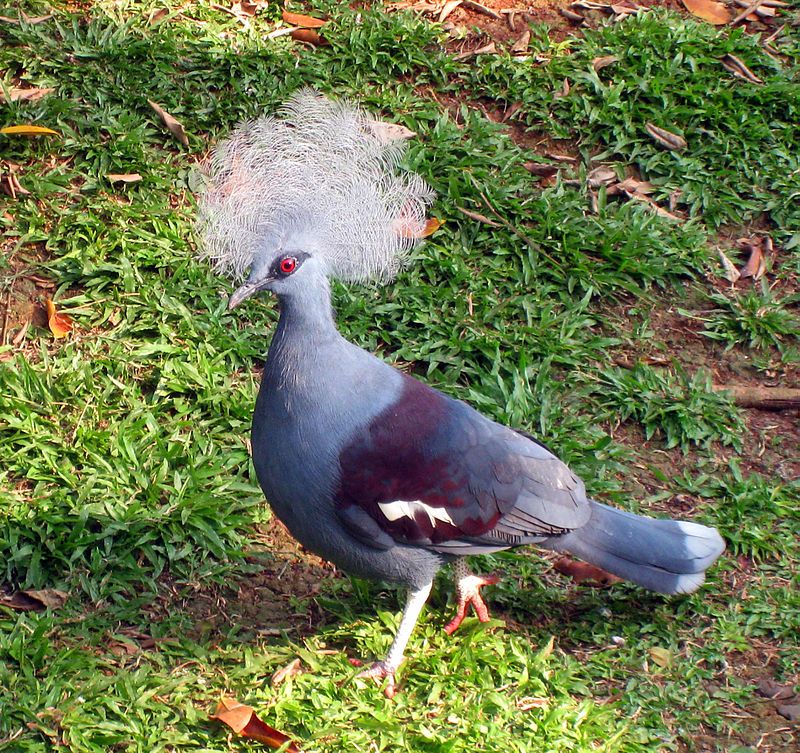
The western crowned pigeon is a large, attractive bird that is distinctive in appearance. It has a blue-grey body, with a lacy blue crest on the head and dark blue mask feathers around its eyes. This gives it a regal look, hence the name crowned pigeon.
Males are usually larger than females, with a length of around 70 cm and a weight of 2.1 kg on average. Despite the differences between them, both sexes are quite similar in appearance.
The western crowned pigeon is native to the lowland forests of New Guinea, where it is a common sight. It feeds mainly on fruit, as well as some seeds and insects. It is an active bird, often seen in pairs or small groups.
It is also a vocal species, producing a variety of coos and other sounds. The western crowned pigeon is a magnificent bird, and its beauty has made it a popular target for hunters. It is now listed as vulnerable and is protected in some areas.
Conservation efforts have been successful in some places, with populations showing signs of recovery. However, much work still needs to be done to protect this stunning species.
| Kingdom | Animalia |
| Phylum | Chordata |
| Class | Aves |
| Order | Columbiformes |
| Family | Columbidae |
| Genus | Goura |
| Species | G. cristata |
5. Pied Imperial Pigeon
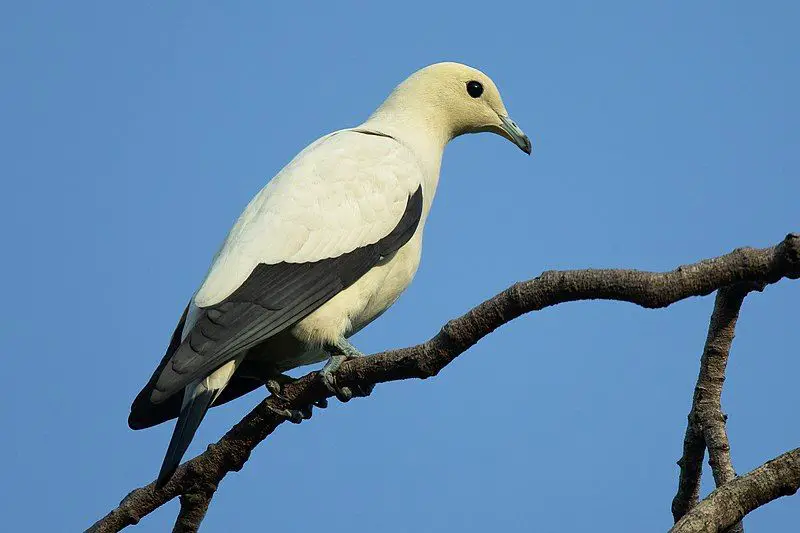
The Pied Imperial Pigeon is a species of pigeon that is larger than most other species. It can be found in a variety of habitats, including forests, woodlands, mangroves, plantations, and scrub, in Southeast Asia.
The range of the Pied Imperial Pigeon extends from Myanmar and Thailand, throughout Indonesia, and east to the Philippines and the Bird’s Head Peninsula in New Guinea.
This species of pigeon is easily identifiable by its distinctive white-black-white pattern. This species of pigeon is an important part of the local wildlife in the countries where it is found. It is a frequent visitor to plantations, where it feeds on various fruits and seeds.
It is also known to feed on smaller invertebrates and insects, which are an important part of its diet.
Furthermore, it plays an important role in the dispersal of seeds, which helps to maintain the health of the local environment. The Pied Imperial Pigeon is a species of bird that is considered to be of least concern by the International Union for Conservation of Nature (IUCN).
This means that, while there are some threats to its populations, they are not considered to be at a level that requires immediate conservation action. These threats include habitat destruction, hunting and trapping, and competition with other species for food.
The IUCN also notes that the population of this species is likely to be decreasing, and recommends that further research is needed to better understand the threats that it is facing.
| Kingdom | Animalia |
| Phylum | Chordata |
| Class | Aves |
| Order | Columbiformes |
| Family | Columbidae |
| Genus | Ducula |
| Species | D. bicolor |
6. Victoria Crowned Pigeon
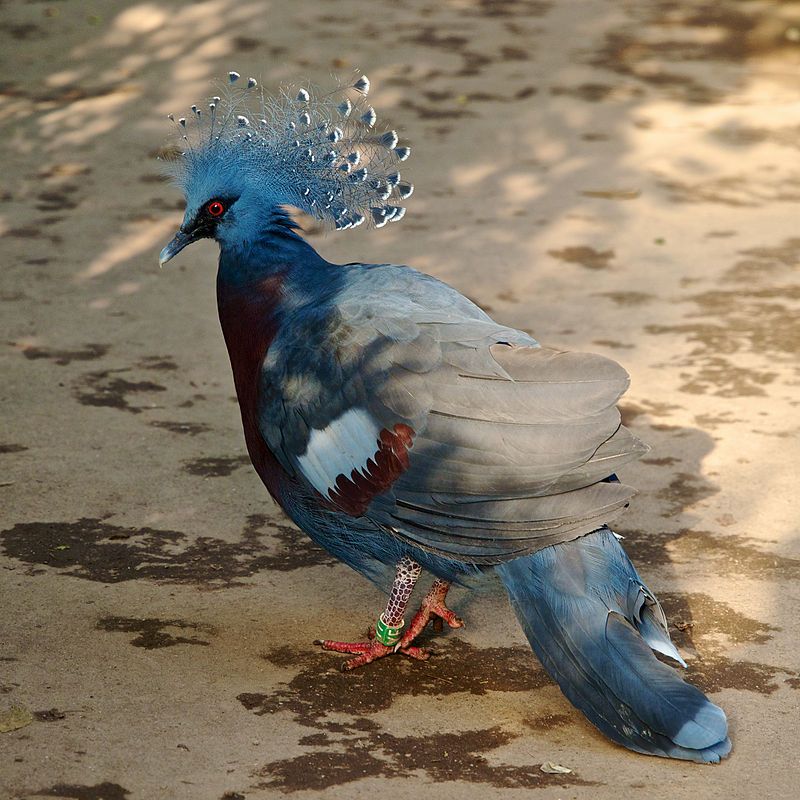
The Victoria crowned pigeon is a stunning bird, native to the New Guinea region. It has a bluish-grey body, with an elegant blue lace-like crest and maroon breasts. Its eyes are a striking red, and they give the bird a unique and distinguished look.
It is part of a genus of four large, ground-dwelling pigeons, and is the largest of all. The Victoria crowned pigeon is the most distinctive of all the species, with its elegant crest and maroon chest.
It is also the largest of the four species, with a body length of up to 70 centimeters. It has long, broad wings and a long tail, which it uses to balance itself while walking on the ground.
The Victoria crowned pigeon is an omnivore, eating a variety of plant matter, fruits, and seeds. It has a loud, unique call, which it uses to communicate with other members of its species.
It is a gregarious bird and will gather in groups of up to 40 individuals to feed or to breed. The Victoria crowned pigeon is a beautiful and unique species, which is unfortunately classified as vulnerable by the IUCN Red List.
It has a small population, and its habitat is threatened by deforestation. It is important to protect this species, as it plays an important role in the New Guinea region’s ecosystems.
| Kingdom | Animalia |
| Phylum | Chordata |
| Class | Aves |
| Order | Columbiformes |
| Family | Columbidae |
| Genus | Goura |
| Species | G. victoria |
7. Wompoo Fruit Dove
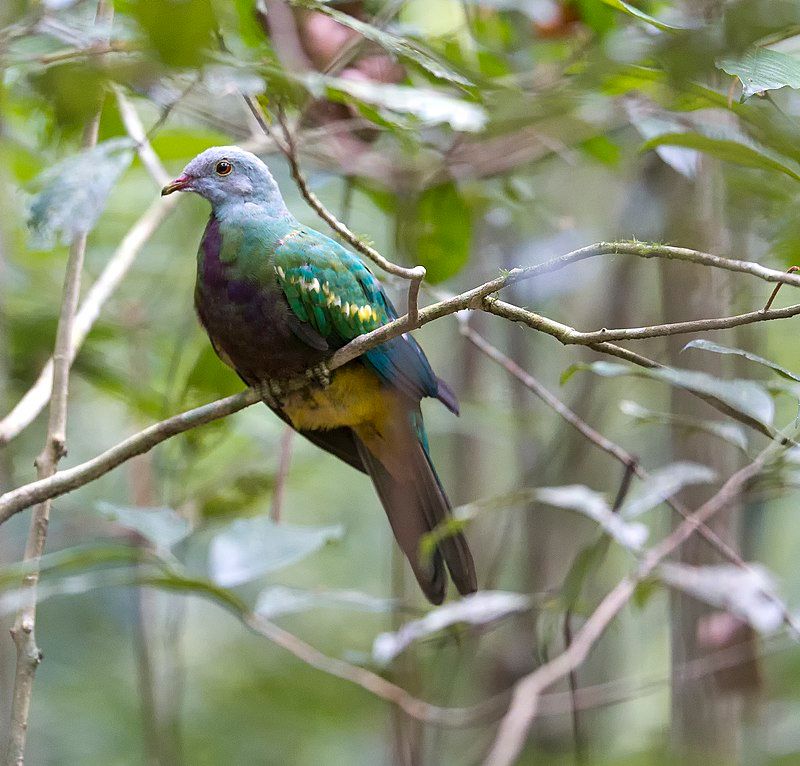
The wompoo fruit dove is a species of fruit dove that can be found in New Guinea and eastern Australia. It is an iconic bird with a distinctive plumage, featuring a brownish-gray body and a bright pink breast.
The head of the dove is black, and its wings are adorned with white stripes. The dove is often seen in pairs and can reach a length of up to 40 centimeters. It is a large species of fruit dove and is capable of producing a loud call that can be heard from afar.
The wompoo fruit dove feeds on a variety of fruits, which it gathers from the forest canopy of its native environment. It is an important seed disperser, helping to spread the seeds of the plants and fruits it consumes throughout its habitat.
In areas where its population is threatened, the wompoo fruit dove is a protected species. Conservation efforts, such as habitat protection, education programs, and reintroduction projects, are being implemented to ensure the survival of this species.
The wompoo fruit dove is a beautiful and important species of bird, and its presence is essential to the health of its environment. It is a species that is worth protecting, and its conservation is essential to the health of the ecosystem.
| Kingdom | Animalia |
| Phylum | Chordata |
| Class | Aves |
| Order | Columbiformes |
| Family | Columbidae |
| Genus | Ptilinopus |
| Species | P. magnificus |
8. Blue Bird-of-paradise
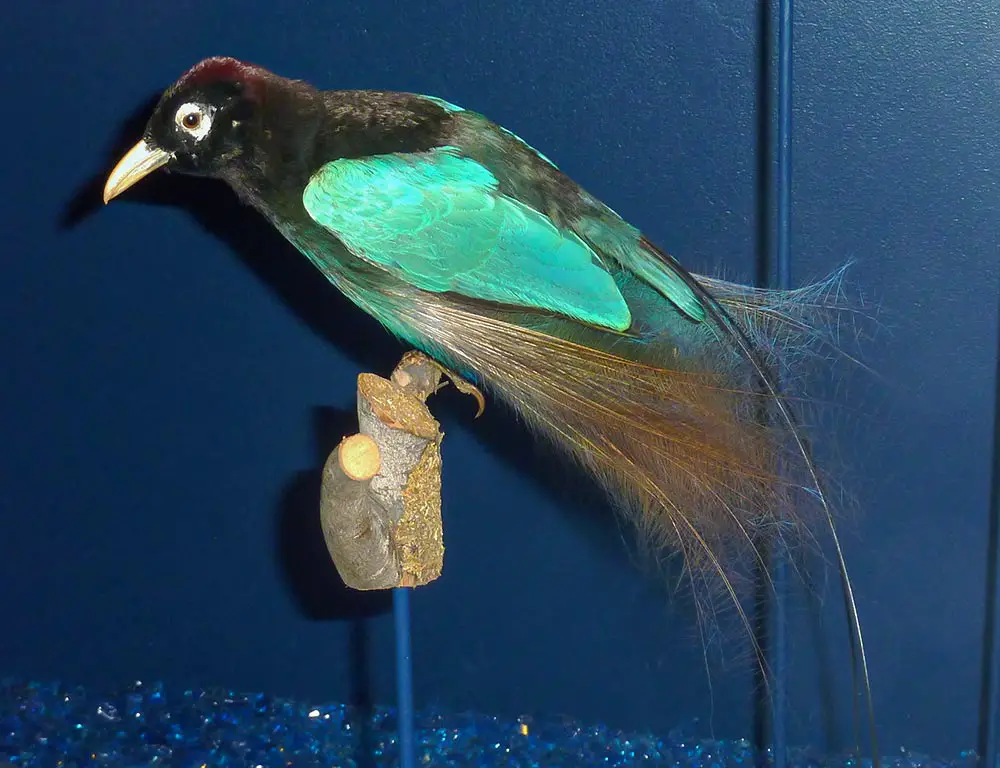
The blue bird-of-paradise is a stunning species of bird-of-paradise. It is characterized by its large size, bright blue plumage, and long tail feathers. The species is part of the family Paradisornithidae and is the only species in the genus Paradisornis.
Before its placement in this genus, the blue bird-of-paradise was included in the genus Paradisaea. This genus is comprised of other species of bird-of-paradise, including the greater bird-of-paradise, the lesser bird-of-paradise, and the raggiana bird-of-paradise.
The blue bird-of-paradise stands out from its relatives, not only by its size and color but also by its unique tail feathers. These feathers are longer and more colorful than those of its relatives, giving the blue bird-of-paradise an even more striking appearance.
The blue bird-of-paradise is truly a sight to behold.
| Kingdom | Animalia |
| Phylum | Chordata |
| Class | Aves |
| Order | Passeriformes |
| Family | Paradisaeidae |
| Genus | Paradisornis |
| Species | P. rudolphi |
9. Lesser Bird-of-paradise
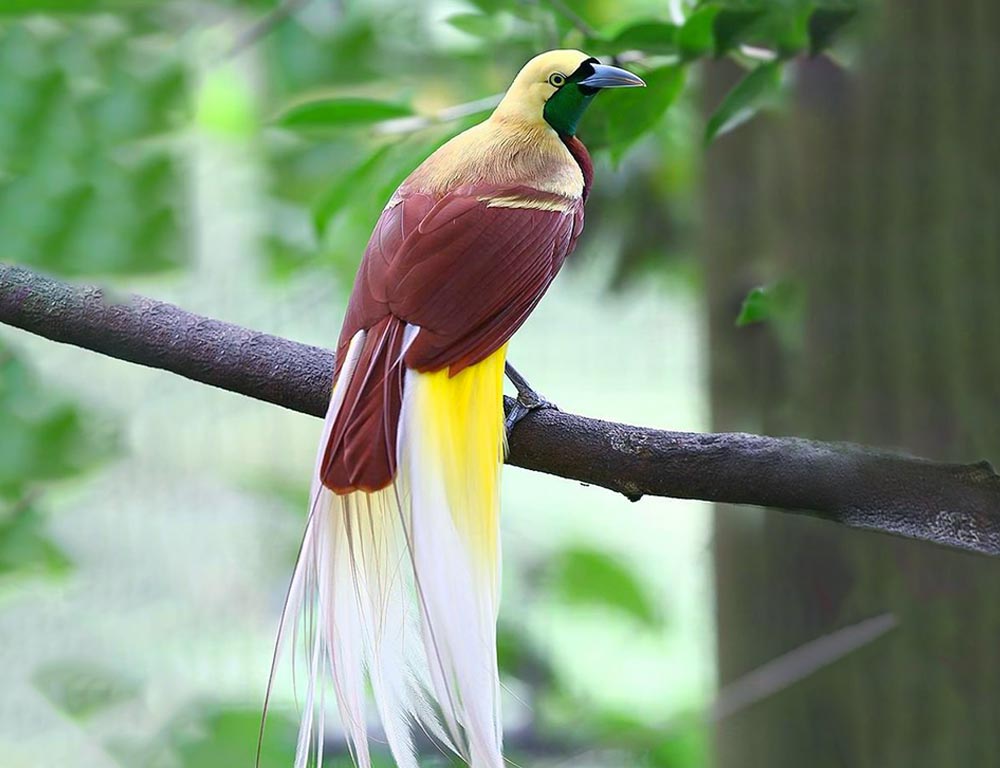
The lesser bird-of-paradise is a species of bird found in the Paradisaea genus. This species is a part of the bird-of-paradise family, which is found in the tropical forests of New Guinea and nearby islands.
The lesser bird-of-paradise is one of the smallest of this family, measuring only about 25 cm in length. It is known for its stunning plumage, which is composed of bright yellow, orange, and black feathers.
The males of this species have a distinctive round crest of feathers on the head and a long tail which they use for courtship displays. The females are smaller and lack crests and long tails, but still have impressive colorful plumage.
The lesser bird-of-paradise is a shy bird and usually stays well hidden in the dense trees of the rainforest, but can be heard making characteristic whistles. It mainly feeds on fruits and small insects..
| Kingdom | Animalia |
| Phylum | Chordata |
| Class | Aves |
| Order | Passeriformes |
| Family | Paradisaeidae |
| Genus | Paradisaea |
| Species | P. minor |
10. Northern Cassowary
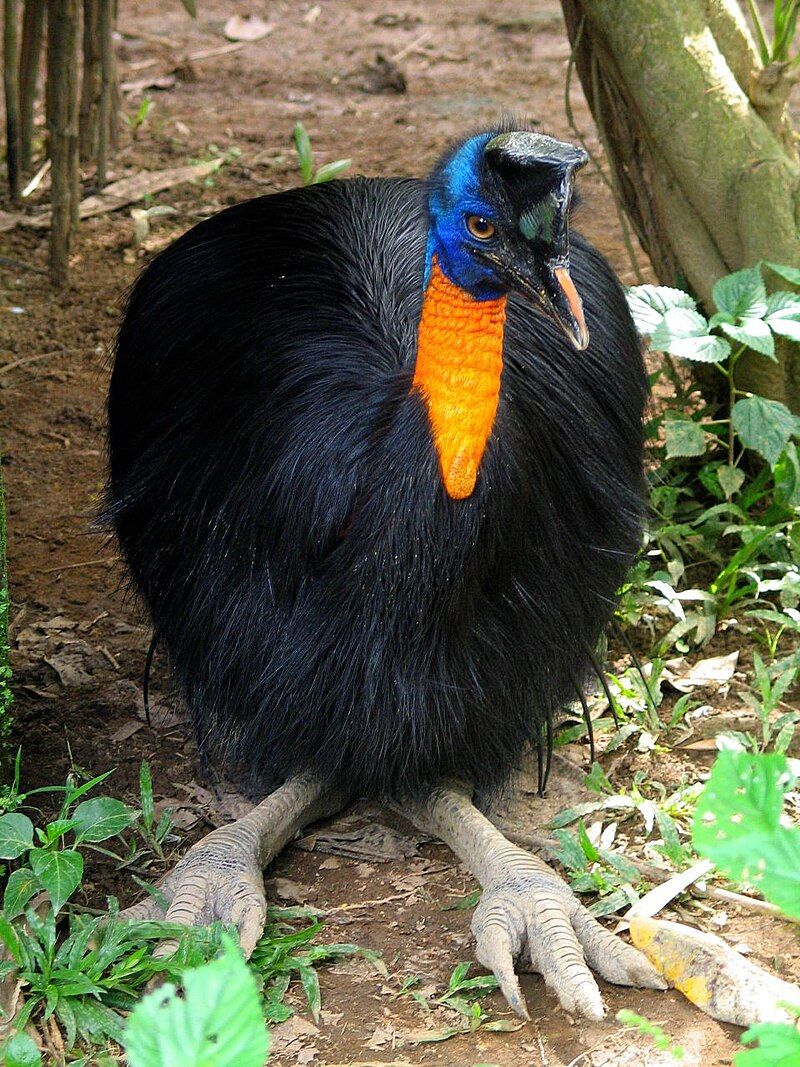
The northern cassowary is a large, stocky flightless bird native to northern New Guinea. It is the largest species of cassowary and is also known as the one-wattled cassowary, single-wattled cassowary, or golden-necked cassowary.
It is one of only three living species of cassowary, the other two being the dwarf cassowary and the southern cassowary. The northern cassowary is an impressive bird, standing up to 1.5 meters tall and having a large, black-feathered body with bright blue and purple neck feathers.
It has a single wattle on its neck, while the southern cassowary has two wattles and the dwarf cassowary has none.
The northern cassowary is a powerful bird, capable of running at speeds of up to 50 kilometers per hour and delivering powerful kicks with its large, clawed feet. The northern cassowary is a shy, solitary bird and is mostly found in the dense rainforests of New Guinea.
It feeds on fruits, fungi, and insects and will also scavenge for carrion.
While they are generally shy and reclusive, they will become aggressive and territorial if provoked. The northern cassowary is listed as Vulnerable by the IUCN Red List and is threatened by habitat loss, hunting, and the illegal pet trade.
Conservation efforts are underway to protect this magnificent bird.
| Kingdom | Animalia |
| Phylum | Chordata |
| Class | Aves |
| Order | Casuariiformes |
| Family | Casuariidae |
| Genus | Casuarius |
| Species | C. unappendiculatus |
11. Marbled Frogmouth
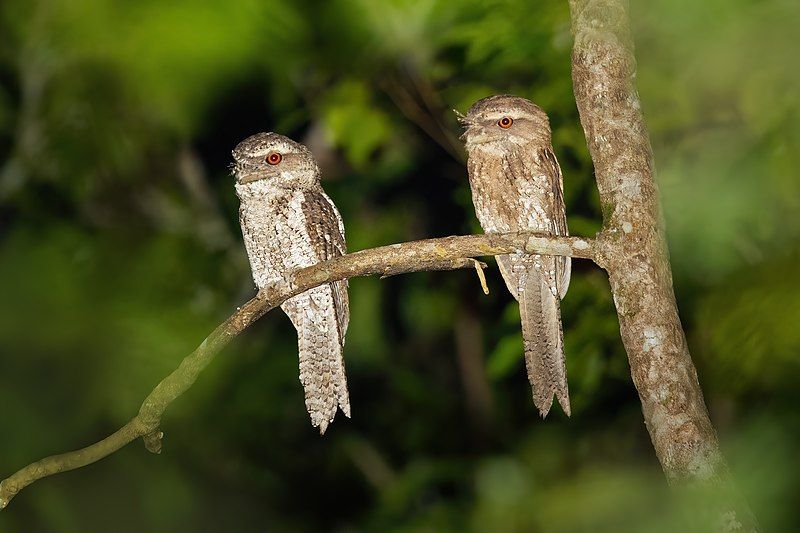
The marbled frogmouth is a species of bird that belongs to the family Podargidae. It was first discovered in 1830 by two French zoologists, Jean René Constant Quoy and Joseph Paul Gaimard. This species is native to the Aru Islands, New Guinea, and Queensland.
The marbled frogmouth is a relatively small bird, with a maximum body length of around 22 cm. It is characterized by its marbled greyish-brown plumage, which helps it to blend in with the surrounding environment. The bird has a wide, flattened head, which gives it its name.
Its large eyes and long, wide bill enable it to hunt for its prey in the dark. The marbled frogmouth is a nocturnal bird, meaning that it is active at night. It feeds mostly on insects, small vertebrates, and occasionally fruits and berries.
Its habitat preferences are open forests and woodlands, where it nests in tree hollows or on the ground. The marbled frogmouth is considered to be at low risk of extinction, but its population is declining due to habitat loss.
Therefore, it is important to protect its habitat to conserve this species for the future.
| Kingdom | Animalia |
| Phylum | Chordata |
| Class | Aves |
| Clade | Strisores |
| Order | Podargiformes |
| Family | Podargidae |
| Genus | Podargus |
| Species | P. ocellatus |
12. Superb Fruit Dove
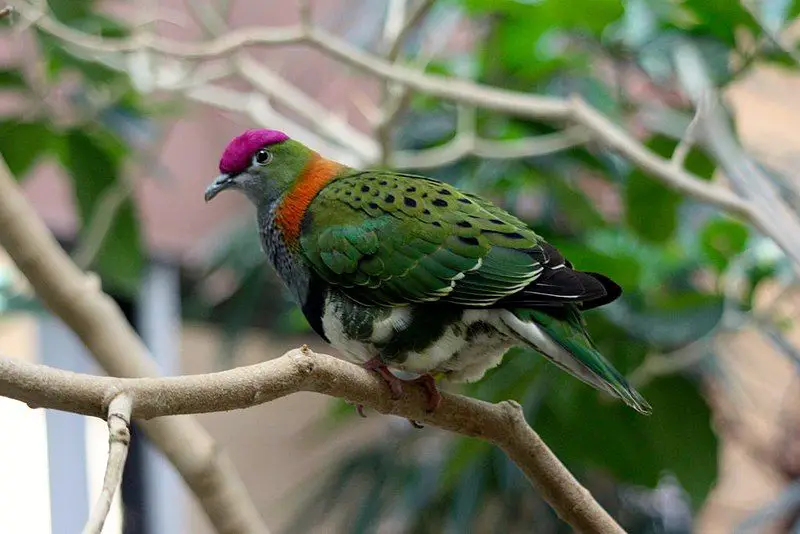
The superb fruit dove is a beautiful and vibrant creature. It is a member of the Columbidae family, commonly known as the fruit dove. The dove is medium-sized and has a distinctive purple crown.
This bird is native to the tropical forests of Australia, New Guinea, and many of the nearby islands.
Its vibrant colors of yellow, blue, green, and purple make it quite a sight to behold. The superb fruit dove has a unique diet consisting of fruits, nuts, and seeds that it finds in the wild.
It is known for its foraging abilities, often visiting gardens and orchards to find its food. It is also known to be a very social creature, often seen in small flocks. The superb fruit dove is a popular pet due to its beautiful plumage and gentle nature.
It is quite easy to train and can be kept in a cage or aviary.
It is a hardy bird and quite resistant to disease, making it an ideal pet for those with limited experience. The superb fruit dove is an important member of the ecosystem, helping to disperse seeds and aiding in pollination. It is also an important food source for many predators.
Unfortunately, its population is declining due to habitat destruction and illegal trapping. Conservation efforts are being made to protect this unique species.
| Kingdom | Animalia |
| Phylum | Chordata |
| Class | Aves |
| Order | Columbiformes |
| Family | Columbidae |
| Genus | Ptilinopus |
| Species | P. superbus |
13. Pinon’s Imperial Pigeon
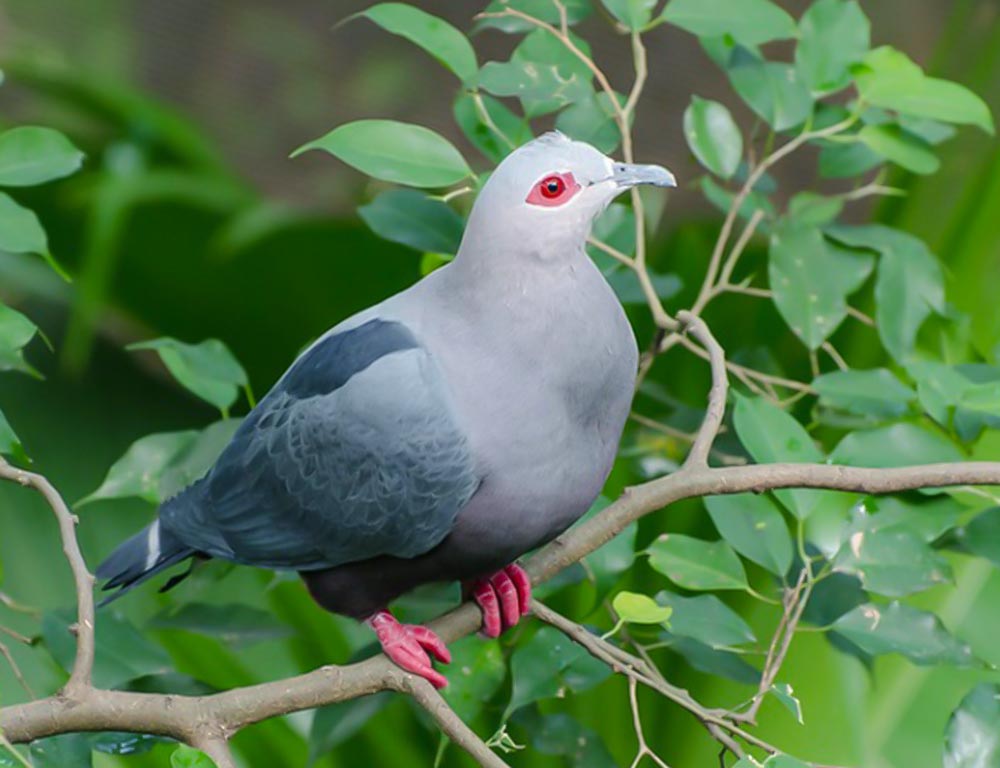
Pinon’s imperial pigeon is a species of bird belonging to the Columbidae family, which is commonly known as the pigeon and dove family.
This species is found in the New Guinea region, the western Papuan Islands, the Aru Islands, and other areas of southern New Guinea from the Mimika River to Hall Sound. It is named after Rose de Freycinet née Pinon, who is its namesake.
Several subspecies of Pinon’s imperial pigeon have been identified, including Ducula pinon. These subspecies can be distinguished based on their range, with some species being more common in certain areas than others.
For example, Ducula pinon is found in the western Papuan Islands, the Aru Islands, and southern New Guinea from the Mimika River to Hall Sound. The species has a large head and a large, broad, and rounded tail, which are both characteristic features of the species.
In addition, they are mainly black or dark grey, with the males being slightly darker than the females. Pinon’s imperial pigeon is a fairly common species, however, its population is declining due to habitat destruction and hunting.
The species is also threatened by the introduction of non-native predators such as cats and rats that prey on eggs and young birds. Conservation efforts are being made to protect the species, such as habitat protection, and the promotion of sustainable hunting practices.
| Kingdom | Animalia |
| Phylum | Chordata |
| Class | Aves |
| Order | Columbiformes |
| Family | Columbidae |
| Genus | Ducula |
| Species | D. pinon |
14. Twelve-Wired Bird-of-Paradise
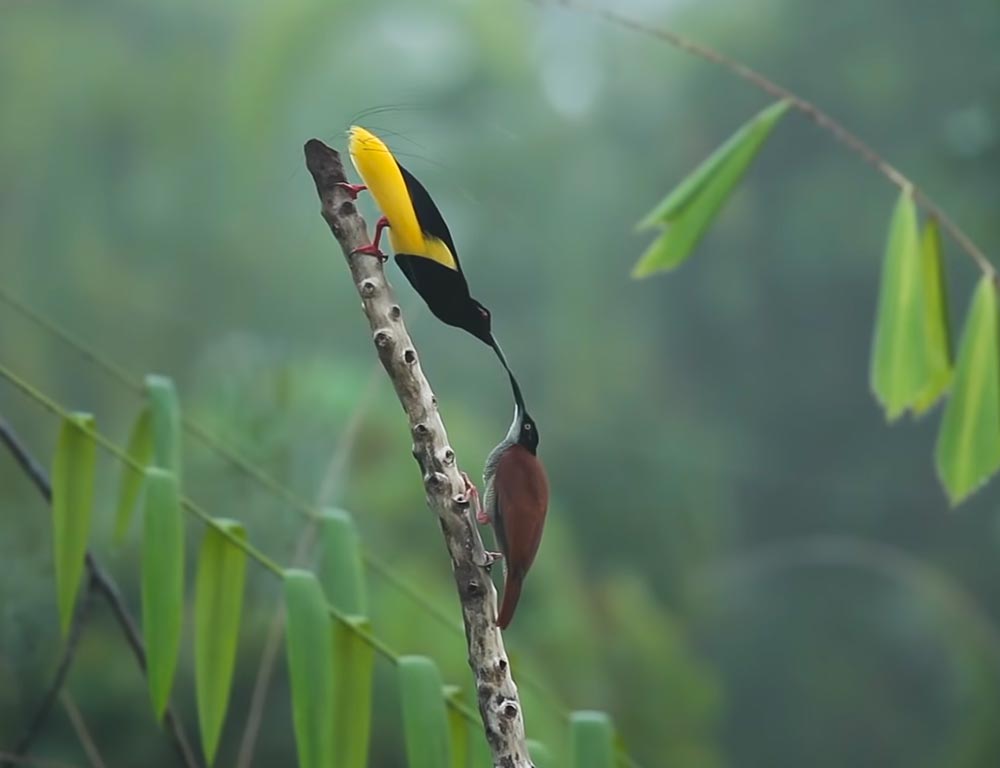
The twelve-wired bird-of-paradise is an impressive avian species that is native to the forests of New Guinea. It is a medium-sized bird, measuring 33 cm in length, and is easily distinguished by its striking jet-black and golden-yellow plumage.
The male of the species has an eye-catching red iris, a long, black curved bill, and a magnificent set of long, yellow plumes that adorn its flanks.
These yellow plumes are especially visible when the male is displaying its courtship ritual, during which the male spreads its wings and performs a unique hopping dance to impress potential mates.
This bird is a true marvel of nature and it is no wonder that it is one of the most sought-after bird-of-paradise species for birdwatchers.
| Kingdom | Animalia |
| Phylum | Chordata |
| Class | Aves |
| Order | Passeriformes |
| Family | Paradisaeidae |
| Genus | Seleucidis |
| Species | S. melanoleucus |
15. Moustached Treeswift
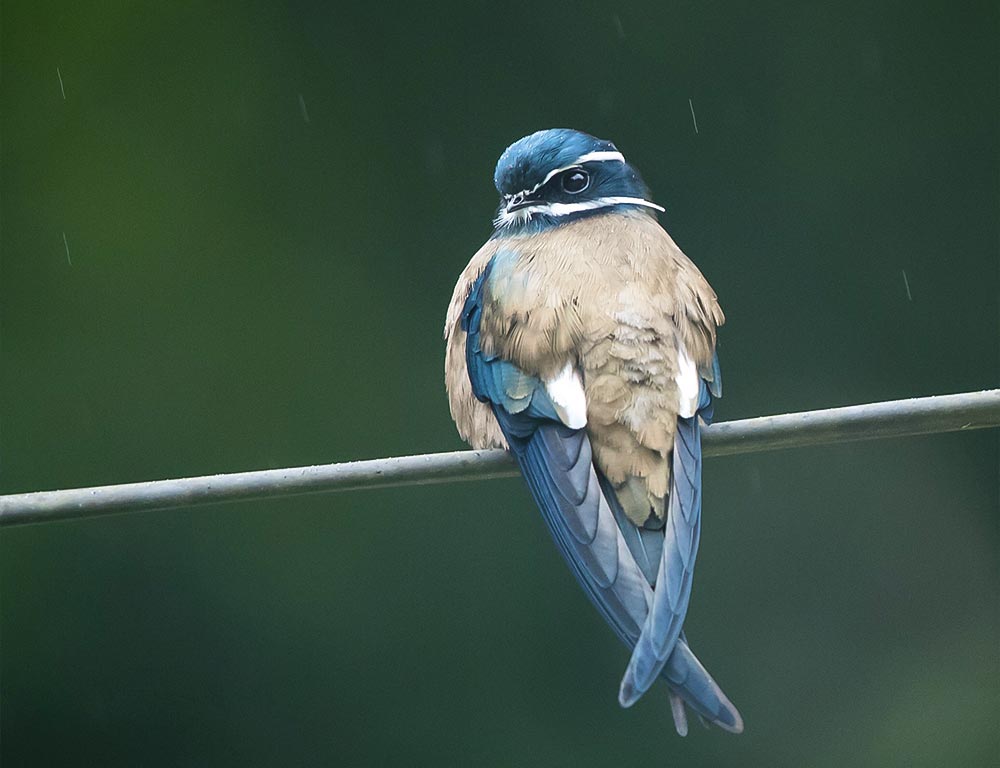
The Moustached Treeswift is a species of bird in the family Hemiprocnidae. It is found in the northern Moluccas and New Guinea, as well as the Bismarck and Solomon Islands archipelagos.
The bird has an easily recognizable mustache-like crest of feathers on its head. The Moustached Treeswift is a small bird, typically measuring around 16 cm in length. It has a greyish-brown head and upperparts, with a white throat and a white rump.
The wings and tail are brown and grey, and the underparts are white. It has a short, broad bill with a hooked tip, and a long, slightly forked tail. The Moustached Treeswift typically inhabits forests, woodland, and savanna habitats.
They are often seen perched on high trees or flying in small groups, searching for insects over the canopy. These birds feed mainly on insects, such as moths, ants, and beetles. The Moustached Treeswift is a migratory species.
It breeds in the northern Moluccas, New Guinea, and the Bismarck and Solomon Islands archipelagos, and migrates to the southern Moluccas, New Guinea, and the Bismarck and Solomon Islands archipelagos in the winter.
The Moustached Treeswift is listed as Near Threatened by the IUCN, due to its small population and the decline in its preferred habitat.
Conservation efforts are needed to ensure the survival of this species.
| Kingdom | Animalia |
| Phylum | Chordata |
| Class | Aves |
| Clade | Strisores |
| Order | Apodiformes |
| Family | Hemiprocnidae |
| Genus | Hemiprocne |
| Species | H. mystacea |
16. Palm Cockatoo
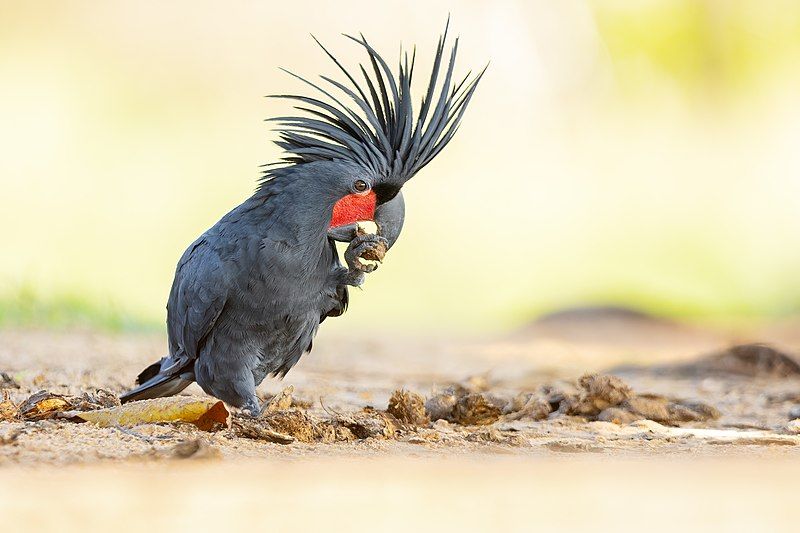
The palm cockatoo is a large, smoky-grey or black parrot, belonging to the cockatoo family of birds. Native to New Guinea, Aru Islands, and Cape York Peninsula, it is also known as the goliath cockatoo or great black cockatoo.
The palm cockatoo has a very large black beak and noticeable red cheek patches, which make it stand out from other parrots.
Its size is also distinctive, as it is the largest species of cockatoo found in Australia and New Guinea and one of the largest species of parrot in the world. The palm cockatoo is a highly intelligent bird, possessing a long lifespan and complex social behavior.
In the wild, they form large flocks of up to several hundred birds. They also have a unique courtship ritual, where the male bird will drum a stick or pod against a branch or trunk to attract a female.
Palm cockatoos have a strong bond with their mate, and they mate for life. The palm cockatoo is an omnivore, and its diet includes fruit, seeds, nuts, buds, insects, and sometimes eggs.
They are also known to feed on the bark and sap of certain trees, which helps them to break down hard seeds and nuts. The palm cockatoo is a threatened species, and its population is declining due to habitat destruction and illegal hunting.
It is listed on the IUCN red list as Vulnerable, and its population is estimated to be between 6,000 and 7,000 individuals. Conservation efforts are being made to protect and increase the population of this unique species.
| Kingdom | Animalia |
| Phylum | Chordata |
| Class | Aves |
| Order | Psittaciformes |
| Family | Cacatuidae |
| Genus | Probosciger |
| Species | P. aterrimus |
17. Megapodes
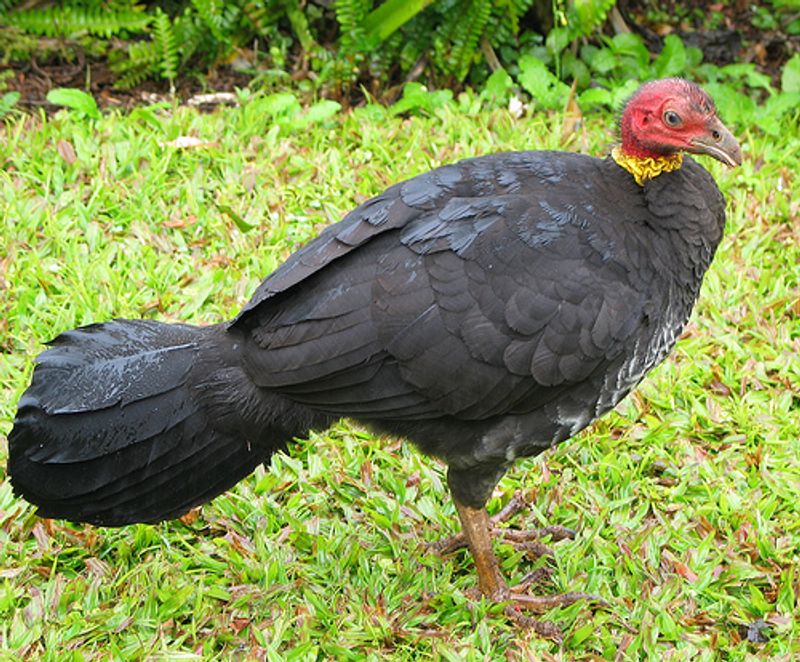
The megapodes, also known as incubator birds or mound-builders, are birds from the family Megapodiidae. They are unique compared to other birds due to their stocky, medium-large build and small heads.
Megapodes are easily recognized by their large feet, which give them their name; the word “megapode” literally translates to “large foot” about the birds’ heavy legs and feet. This size and shape of their feet and legs make them well-suited to a terrestrial lifestyle, meaning they spend most of their time on the ground.
Megapodes have short wings and do not fly long distances, but they can run quickly and maneuver in tight spaces.
They are mostly found in tropical and subtropical regions of Australia, New Guinea, and the islands of the South Pacific. In addition to their unique physical characteristics, megapodes are also known as incubator birds or mound-builders.
This is because they are the only birds in the world to use external heat sources to incubate their eggs. They build large mounds out of dirt, leaves, and decaying vegetation and use the heat generated by the decomposition process to warm their eggs.
The female megapode will lay her eggs in the mound and then cover them with the material before leaving. The male megapode will then take over the duties of caring for the eggs until they hatch. Overall, the megapode is a unique bird with some interesting characteristics.
They are stocky, medium-large birds with small heads and large feet, and their name translates to “large foot” about their heavy legs and feet.
They also have the remarkable ability to use external heat sources to incubate their eggs, which sets them apart from other birds.
| Kingdom | Animalia |
| Phylum | Chordata |
| Class | Aves |
| Order | Galliformes |
| Family | Megapodiidae |
18. Dusky Megapode
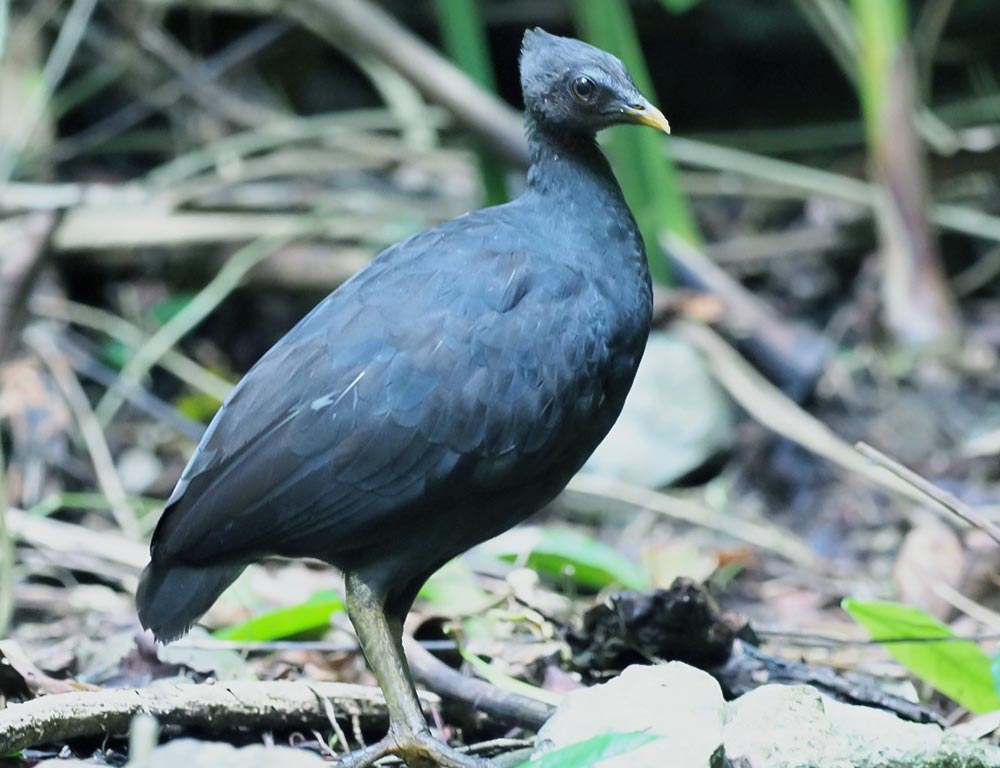
The dusky megapode is a species of bird native to Australia and New Guinea. It is medium-sized, measuring approximately 41 cm in length. It has a blackish body, with a short pointed crest, bare red facial skin, dark legs, brown irises, and a dark brown and yellow bill.
The male and female of the species are similar in appearance, with identical plumage and coloring. The dusky megapode is a ground-dwelling bird, that prefers to live in open woodlands, grasslands, and coastal scrub.
Its diet consists mainly of insects, seeds, fruits, and other vegetable matter. It forages for food on the ground and is known to congregate in large flocks during the breeding season.
The dusky megapode is a shy and skittish bird, and when disturbed, will take to flight, quickly and powerfully. Its call is a loud, cackling “ka-ka-ka-ka” noise, which can be heard from some distance away.
It is also known to make a distinct “booming” sound during the breeding season. The dusky megapode is listed as “Near Threatened” on the IUCN Red List, due to ongoing and increasing deforestation of its natural habitat.
Conservation efforts are underway to help protect this species and its habitat.
| Kingdom | Animalia |
| Phylum | Chordata |
| Class | Aves |
| Order | Galliformes |
| Family | Megapodiidae |
| Genus | Megapodius |
| Species | M. freycinet |
19. Great Cuckoo-dove
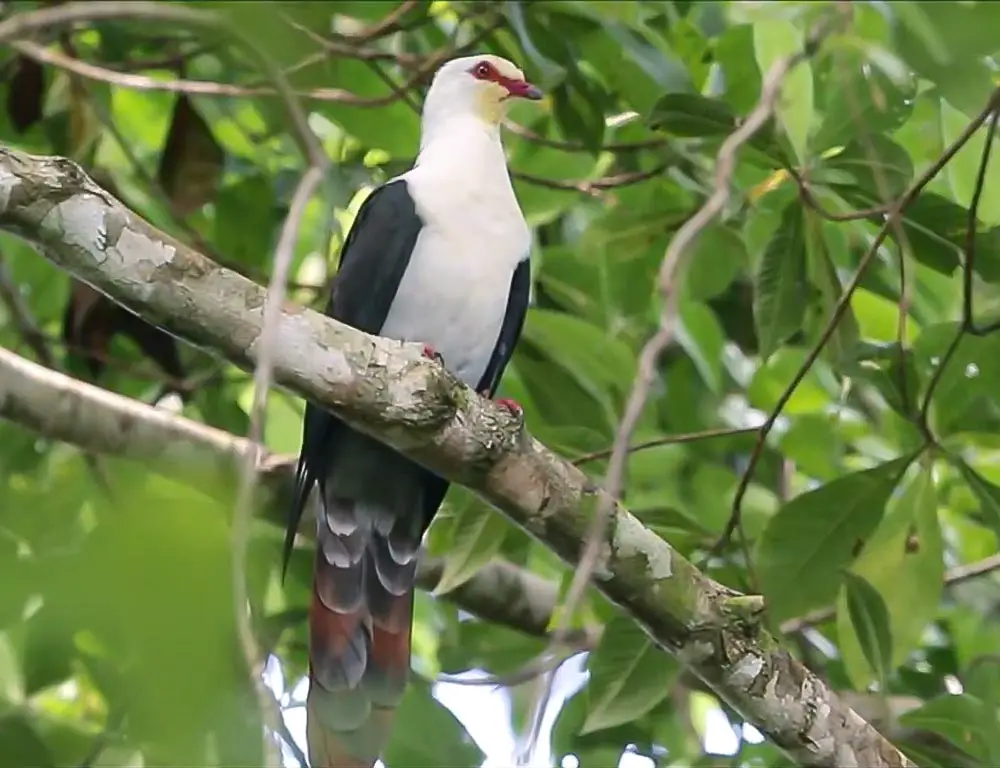
The great cuckoo-dove is a species of bird found in the Maluku Islands and New Guinea. It belongs to the family Columbidae, which includes doves and pigeons. The cuckoo-dove is an interesting bird as it makes its nest in rock gorges near waterfalls.
This is an unusual place for a bird to nest, as it requires the bird to have excellent climbing ability.
It is also very noisy, as the cuckoo-dove is known for its loud two-part call of “wok-wu.” This call is often heard above the sound of the waterfalls and is what makes the bird so easily identifiable.
The great cuckoo-dove is an important part of the Maluku Islands and New Guinea’s ecosystem, as it helps to pollinate plants and disperse seeds.
| Kingdom | Animalia |
| Phylum | Chordata |
| Class | Aves |
| Order | Columbiformes |
| Family | Columbidae |
| Genus | Reinwardtoena |
| Species | R. reinwardti |
20. Rock Dove
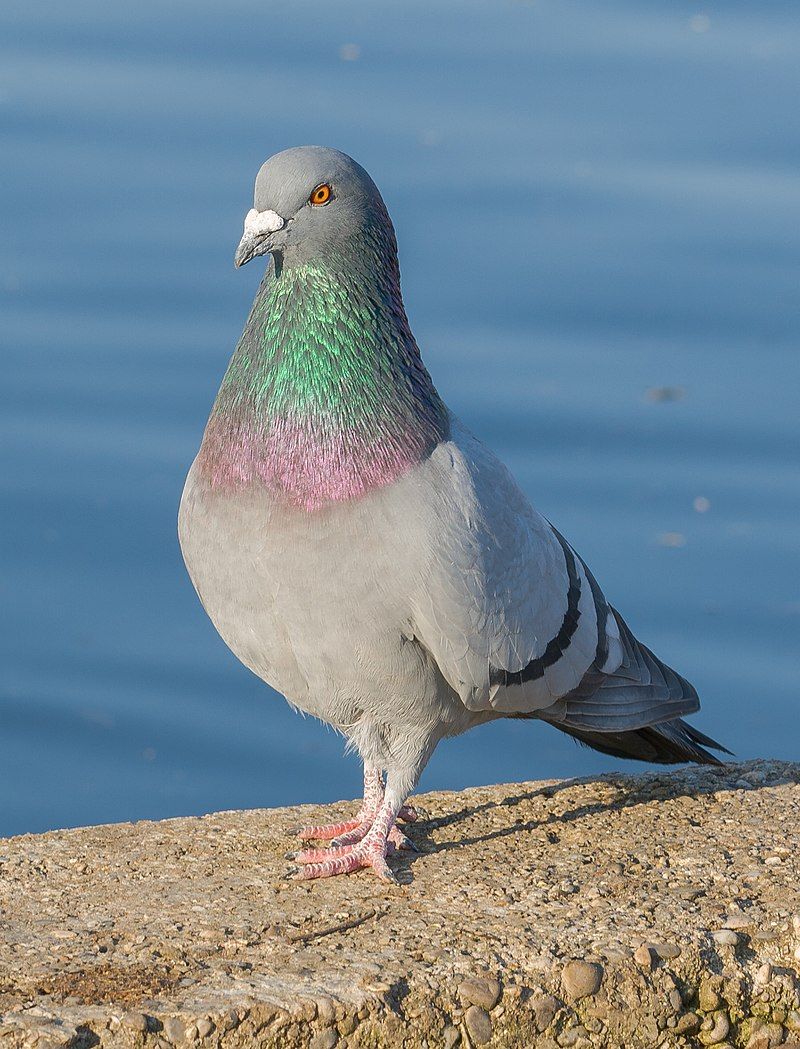
The rock dove, rock pigeon, or common pigeon is a species of bird that belongs to the Columbidae family. It is commonly referred to as the “pigeon” and is the ancestor of the domestic pigeon.
Domestic pigeons were once kept as pets, but some have escaped and populated the world with feral pigeons. This has caused an increase in the global population of the rock dove. The rock dove is a social bird and often lives in large flocks.
They can be found in a variety of habitats, including urban, rural, and agricultural landscapes. They are also quite adaptable to human presence and can feed on a wide variety of food sources, including scraps from people.
The rock dove is a hardy species and can survive in a variety of environments.
| Kingdom | Animalia |
| Phylum | Chordata |
| Class | Aves |
| Order | Columbiformes |
| Family | Columbidae |
| Genus | Columba |
| Species | C. livia |
21. Orange-bellied fruit dove
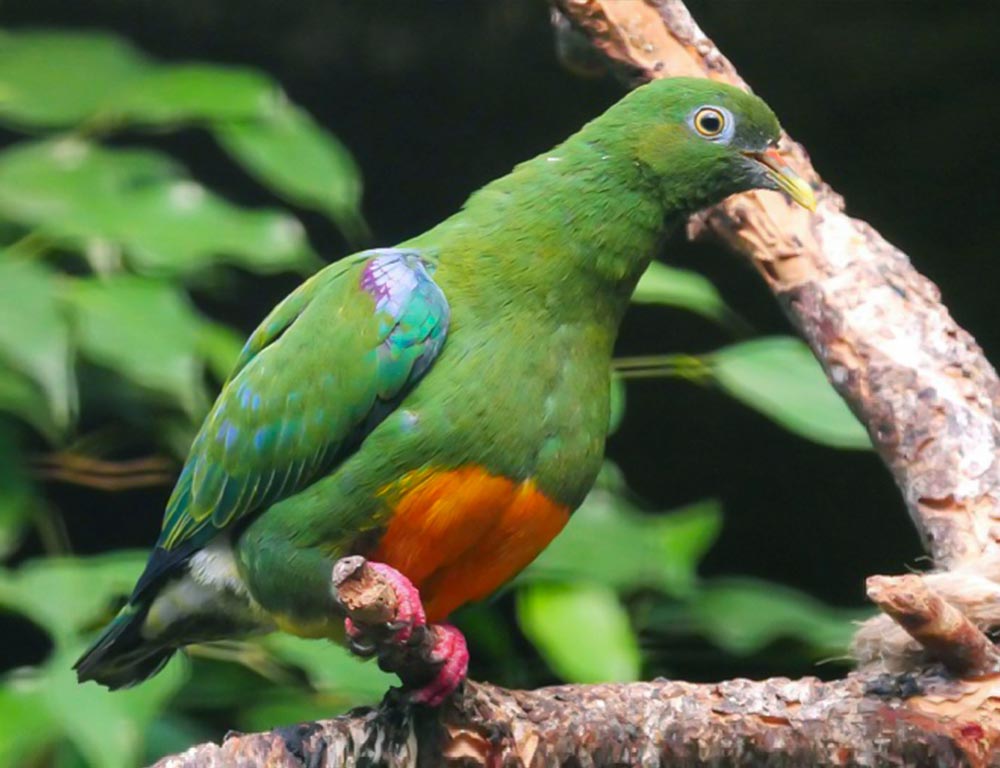
The orange-bellied fruit dove is an attractive small pigeon species, easily recognizable by its distinct plumage. It is mainly green with a few other colors that set it apart. On the lower breast and belly, a large orange patch is visible, giving the bird its name.
There is also a small lilac patch on the shoulders, pale yellow under tail coverts, and a grey terminal band on the tail.
These colors are all subtle but make the bird stand out in a crowd. The orange-bellied fruit dove is a relatively small bird, usually measuring around 10-11 cm in length and weighing just 25-30 g. It is a solitary species, usually encountered in small groups of up to 10 birds.
It has a wide range, inhabiting forests, woodlands, and open country in parts of Australia, Indonesia, and New Guinea. The diet of the orange-bellied fruit dove consists mainly of fruits and seeds, with occasional insects.
It is commonly seen in trees, searching for food or resting. They can also be found near the ground, where they forage for seeds and fallen fruits. The orange-bellied fruit dove is an important species in the wild and is protected in many areas.
It is an important component of the local ecosystem, and its presence is essential for the health of the environment.
| Kingdom | Animalia |
| Phylum | Chordata |
| Class | Aves |
| Order | Columbiformes |
| Family | Columbidae |
| Genus | Ptilinopus |
| Species | P. iozonus |
22. Pink-spotted Fruit Dove
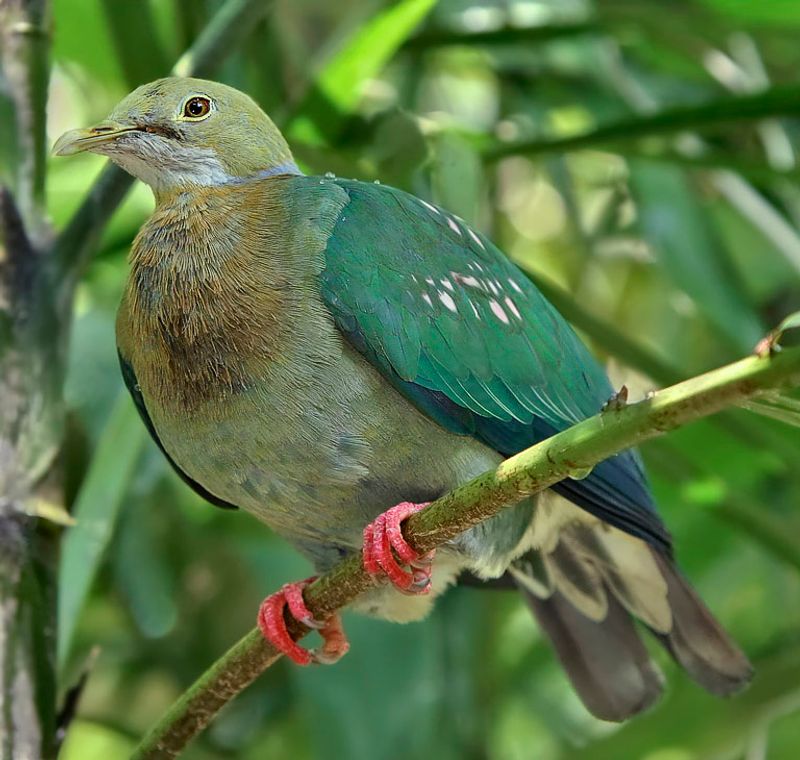
The pink-spotted fruit dove is a species of bird that belongs to the Columbidae family. It is found mostly in forests and woodlands located in the lowlands and foothills of New Guinea and its nearby smaller islands.
The species is widely distributed and is generally considered to be common in its range. The dove is a colorful bird, with a striking pink spot on its wings that makes it unmistakable in its natural environment.
It is a small to medium-sized bird, measuring about 20-25 cm in length and weighing around 80-100 grams. Its plumage is mostly brown and gray, with a few lighter shades.
The wings and tail are tipped with white feathers and it has a black head and throat. The diet of the pink-spotted fruit dove consists mainly of fruits and berries, but it also feeds on insects and other small invertebrates.
It typically forages alone or in small groups, but can sometimes form large flocks. This species is monogamous and forms long-term pair bonds with its mate. The pink-spotted fruit dove is considered to be of least concern on the IUCN Red List of Threatened Species.
Although it is widely distributed and generally common, its population is thought to be declining due to the destruction and degradation of its natural habitat. Conservation measures to protect this species and its habitat are needed to ensure its long-term survival.
| Kingdom | Animalia |
| Phylum | Chordata |
| Class | Aves |
| Order | Columbiformes |
| Family | Columbidae |
| Genus | Ptilinopus |
| Species | P. perlatus |
23. Australian White Ibis
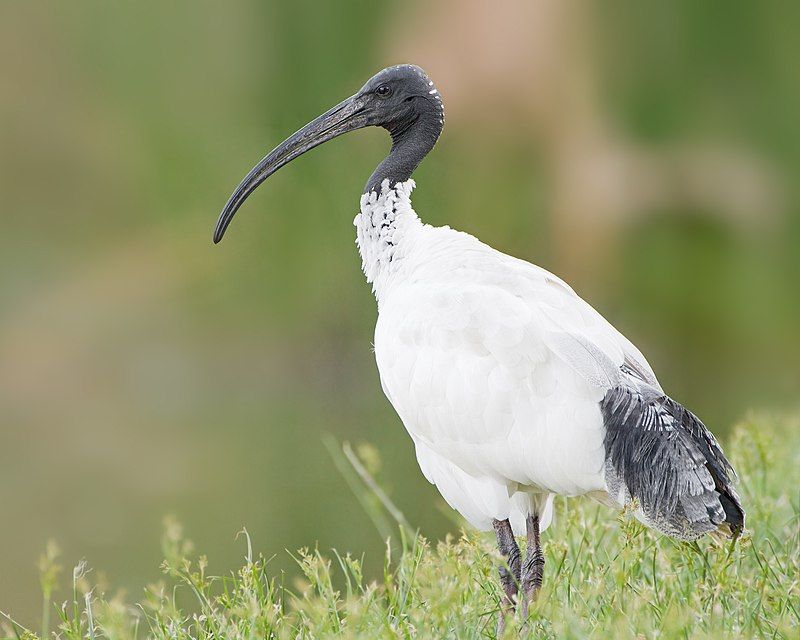
The Australian white ibis is a species of wading bird that is part of the ibis family, Threskiornithidae. It is found across much of Australia and is easily recognizable by its white feathers, black head, long downcurved bill, and black legs.
Its white plumage is its most striking feature, as it stands out in sharp contrast to its dark head and legs.
The long downcurved bill is used for probing into the mud to find food, and its black legs are strong and able to support its weight in the shallow waters where it often feeds.
This bird has adapted well to the Australian environment and its white feathers help it to blend in with the light-coloured sand or mudbanks. It is a common sight in many Australian habitats, from coastal wetlands to inner-city parks and gardens.
| Kingdom | Animalia |
| Phylum | Chordata |
| Class | Aves |
| Order | Pelecaniformes |
| Family | Threskiornithidae |
| Genus | Threskiornis |
| Species | T. molucca |
24. Red Bird-of-paradise
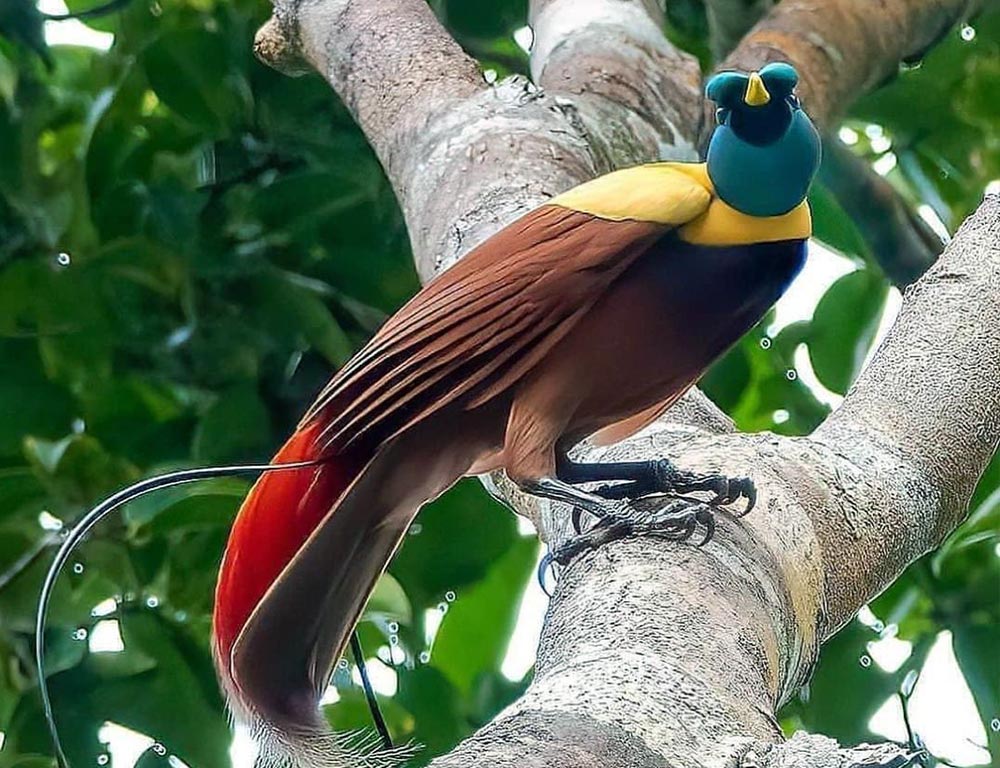
The red bird of paradise is a beautiful and exotic species of bird that is native to Indonesia, New Guinea, and the Maluku Islands. It is also known as the cendrawasih merah in Indonesian.
This species belongs to the genus Paradisaea, which is a group of birds of paradise from the family Paradisaeidae and is known for its intricate courtship dances and bright colors.
The red bird-of-paradise is a medium-sized bird that can reach up to 11 inches in length and has a mainly red body with some black markings.
The males of this species have long tail feathers that they use to attract potential mates, and can be seen performing complex aerial courtship dances. The red bird of paradise lives in lowland forest habitats and feeds mainly on insects, small fruits, and nectar.
It is a threatened species due to habitat loss and illegal trapping for the pet trade and is listed as vulnerable on the IUCN Red List.
| Kingdom | Animalia |
| Phylum | Chordata |
| Class | Aves |
| Order | Passeriformes |
| Family | Paradisaeidae |
| Genus | Paradisaea |
| Species | P. rubra |
Conclusion
Birds in South Papua are a wonderfully diverse and abundant group of species. With many species of both endemic and migratory birds, there are a wide variety of avian species to be found in the region.
Birdwatchers, scientists, and nature enthusiasts alike will find plenty of opportunities to observe and learn about these amazing birds in South Papua..